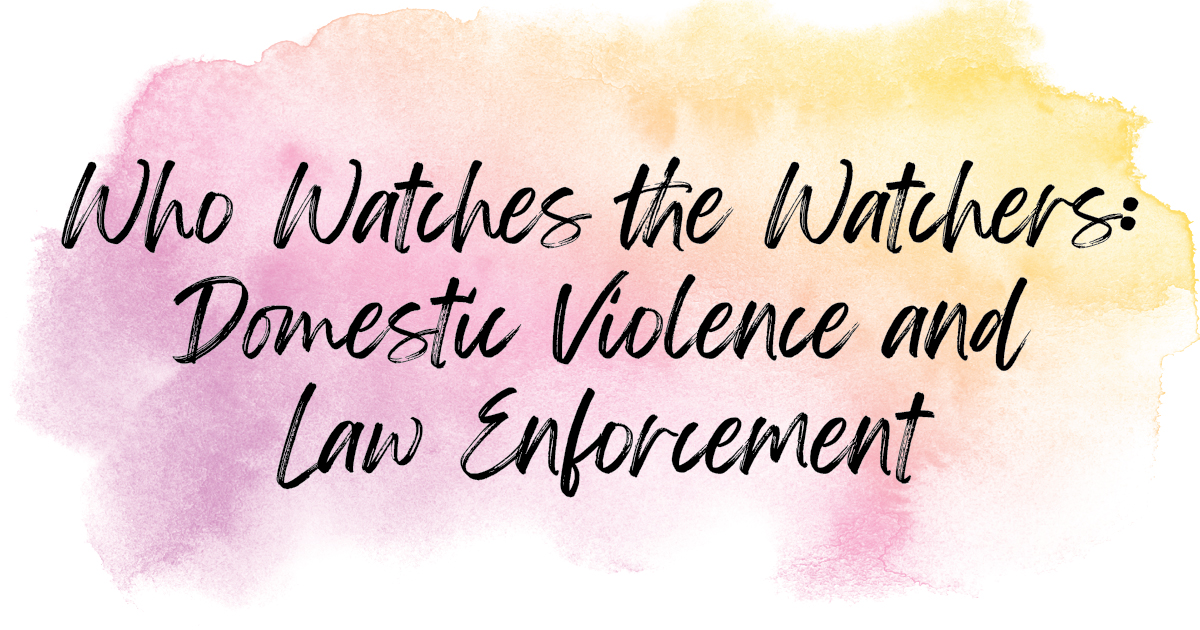
The average messaging of most anti-violence organizations include some variation on the following: “If you are in immediate danger, call 911.” Embedded in directing a victim of violence to call 911 is a key assumption—that law enforcement will make that person safer. But the headlines regularly feature stories of law enforcement officers accused of abuse: of their own partners, the victims they’re supposed to be helping, and incarcerated survivors of violence.
On December 29, 2022 in Florida, Cocoa police officer Patrick Kelly was charged with aggravated assault after threatening his girlfriend (also a police officer) with a gun. This wasn’t Kelly’s first arrest for domestic violence. In 2017, Kelly was charged with felony domestic violence battery. Kelly admitted to strangling his girlfriend during an argument but was permitted to remain on the police force after the charges were dropped.
In November 2022, New Orleans Police Department officer Rodney Vicknair pled guilty to sexually assaulting a 15-year-old sexual assault victim he met while escorting her to the hospital for a forensic exam. Between May and September in 2020, Vicknair repeatedly phoned and texted the victim and made unscheduled visits to her home. In September 2020, Vicknair locked the victim into his car and sexually assaulted her again.
Ray Garcia, the former warden at the federal correctional institution in Dublin, California, was found guilty in December 2022 of eight counts of sexually abusing incarcerated women. Garcia sexually assaulted at least three women, ordered incarcerated women to strip for him, and kept pictures of the women on his phone. The prison’s chaplain, James Highhouse, also took part in the Dublin “rape club.”
These three examples are the tip of the iceberg. Although the studies are dated, research has found that police officers are more likely to abuse their intimate partners than other people. Activist and scholar Andrea Ritchie’s book Invisible No More: Police Violence Against Black Women and Women of Color documents numerous incidents of police victimizing people who turn to them for help. Sexual abuse similar to the that found in the Dublin facility runs rampant in the prison system; a recent report documented sexual abuse of women in at least 19 of the 29 federal prisons where women were housed between 2012 and 2022. Abuse of both victims seeking out services and incarcerated people by law enforcement disproportionately affects low-income women of color, who are more likely to be targeted by police and to be in penal facilities.
Why are acts of sexual and intimate partner violence so prevalent among law enforcement? In my 2015 article Hands Up At Home: Militarized Masculinity and Police Officers Who Commit Intimate Partner Abuse, I argued that law enforcement cultivates a culture of militarized masculinity which attracts combative personalities with a propensity towards violence. Moreover, law enforcement officers are taught to dominate, to be in control at all times, and to punish anything they perceive as disrespect to preserve their authority. The same traits that make someone “effective” as a police or correctional officer make them more likely to use violence against their partners, the victims of violence they were sworn to protect, and the incarcerated people whose care is entrusted to them.
Yet we continue to rely on the criminal legal system as our primary response to intimate partner and sexual violence, with law enforcement characterized as “protectors rather than…perpetrators of violence against women.” We train officers to be particularly skilled abusers, teaching them to intimidate, to obtain information through interrogation and surveillance, and use force without causing visible injury. We encourage community-based anti-violence agencies to partner with law enforcement, effectively rendering their services inaccessible to those whose partners or perpetrators are police officers. We incarcerate survivors of gender-based violence and leave them vulnerable to further trauma at the hands of law enforcement. None of that will change so long as the criminal legal system flourishes.
Abolition feminism offers an alternative. Abolition feminism is, quite simply, “feminism that opposes, rather than legitimates, oppressive state systems” like policing and prisons. Abolition feminists like Angela Davis, Beth Ritchie, and Mariame Kaba have characterized abolition as a form of anti-violence work; for these thinkers, it is impossible to be an anti-violence feminist without also being an abolition feminist.
Abolition is a long-term project. However, there are steps that we can take along the way to create greater safety and support for victims of officer-involved gender-based violence. We can have conversations about shifting resources away from status quo systems and how to turn those into preventative services. We can empower non-carceral first responders to address victims’ needs and escort them safely to hospitals or other forms of care. We can build and support community-based transformative justice projects that empower communities to intervene in the aftermath of violence in order to establish accountability without relying on police. We can examine laws like the Violence Against Women Act to reconsider how they require or incentivize anti-violence agencies to collaborate with police.
For every case of law enforcement gender-based violence that becomes public, there are hundreds that we never hear about. Law enforcement officers are part of a structure that gives rise to and fosters violence. The problem is not simply one of “bad apples”; law enforcement sits in a deeply racist, sexist, and violent culture. Criminalization cannot be an effective response to gender-based violence when those policing the crime and those committing it are often one and the same.
About the Author

Professor Leigh Goodmark is an internationally recognized authority on gender-based violence. Her legal work, scholarship, and commentary focus on aspects of gender-based violence including race, intersectionality, criminalization, and incarceration. She is the author of Imperfect Victims: Criminalized Survivors and the Promise of Abolition Feminism (2023), Decriminalizing Domestic Violence: A Balanced Policy Approach to Intimate Partner Violence (2018), and A Troubled Marriage: Domestic Violence and the Legal System. She is the co-editor of The Criminalization of Violence Against Women: Comparative Perspectives (2023) and Comparative Perspectives on Gender Violence: Lessons from Efforts Worldwide (2015).
Resource Topics Sexual Assault Awareness Month
